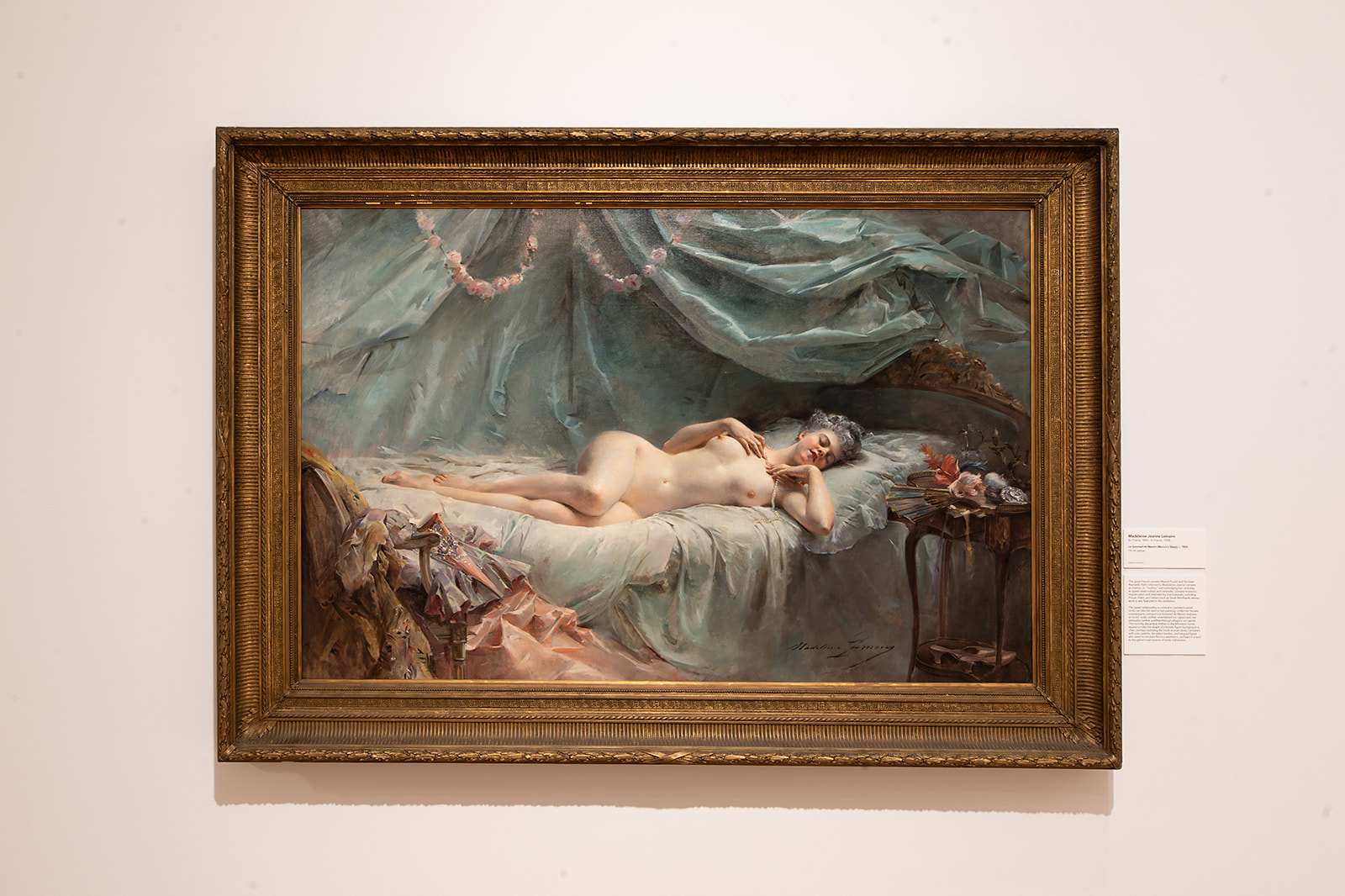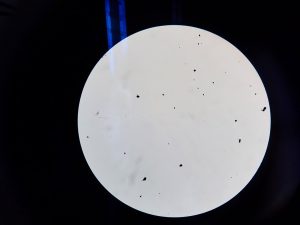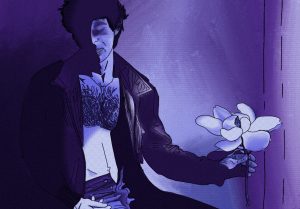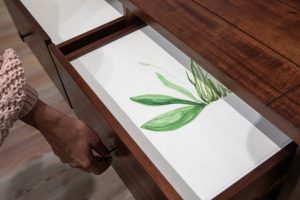My favorite picture of you is from New Year’s Day after we returned from your friend’s party. We argued beforehand about what you should wear. I insisted you wear the black slip dress instead of jeans and a sheer blouse because I thought the dress made you look diaphanous, like a thin stream of cigarette smoke. The party is chic themed, I said, exasperated, as if this was an unassailable defense of my outfit suggestion. You acquiesced.
We kissed at midnight in the hallway and a second time outside your friend’s apartment, a development that surprised me. Neither of us considered ourselves lesbian or even bisexual. I ordered an Uber. We woke up together in my bed, and I whispered, Good morning, Avery. You were hungover, and your breath was slightly sour. You watched as I packed my suitcase for a flight to Lisbon that would leave later that evening.
As I rummaged through my closet, deciding which outfits to bring on my weeklong trip, I discovered the lavender fur hat I purchased at the Renaissance Fair a few years earlier. I handed you the hat and asked you to wear it. You resisted for a moment before indulging my playful styling. The hat engulfed you, like a sunflower that droops heavily from the weight of its blossom.
I asked if I could take a Polaroid. You protested. I insisted, and again you entertained me. Later, I would consider this evidence of your patient nature and infatuation.
When the photo finished developing, I showed it to you and gushed, telling you how beautiful you looked. In the photo, you are looking away from the camera, your eyes fixed somewhere in the corner of my room, and your arm is carefully laid across your body, like a rope suggesting an impassable boundary. You are sitting in a pile of tangled blankets and pillows. Your hand rests on a pair of jeans I gifted you later that day, before my departure.
Our goodbye was awkward and curt. Neither you nor I could vocalize our apprehension about the length of my trip; we saw each other daily, often walking the same route through our neighborhood. A route you introduced to me, I should add.
On the plane, I inspected a scan of this Polaroid. You would never wear this outfit anywhere, but I was buoyed by the image because you were willing to be the subject of my observation. And because you allowed me to imbue you with an uncharacteristic, Bohemian persona, at least for the duration of this image.
Avery, I thought of you, this Polaroid, and the collection of Polaroid photographs I’ve taken of friends as a practice of friendship and a community archive, when I visited The First Homosexuals: The Birth of a New Identity, 1869-1939 at Wrightwood 659, a dizzying exhibition presenting more than 300 works to explore how representations and public perception of homosexuality changed after the term “homosexual” was coined in 1869. I was entertaining the idea of writing about queer portraiture generally, and my own, because I thought this attempt to capture the likeness or personality of another person was a transformative act of witnessing, especially for queer or trans people.
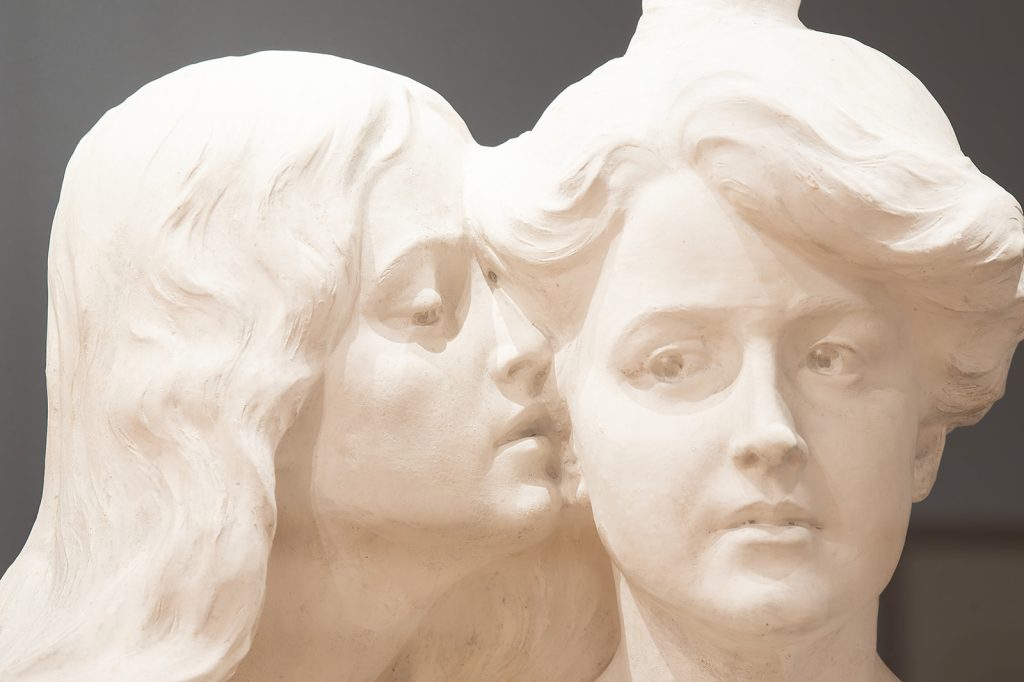
The First Homosexuals curator and associate curator, Jonathan D. Katz and Johnny Willis, respectively, examined how the introduction of the term homosexual altered how we collectively understand same-sex desire. They demonstrate that same-sex desire, up until the early twentieth century, was understood as “more of a liking, a taste, an individual preference, albeit generally, a persecuted one” rather than an innate, natural orientation.
Homosexuality, as an identity, was coined in a series of letters exchanged between the Hungarian journalist Karl Maria Kertbeny and German lawyer and journalist Karl Heinrich Ulrichs. In the early 1860s, Ulrichs published a series of pamphlets arguing that same-sex attraction was innate and should not be persecuted. He thought same-sex attracted men had a “woman’s soul enclosed in the body of a man” and sought to shift public perception of same-sex attracted individuals, arguing their sexual orientation was biologically predetermined, to campaign against laws that criminalized people who engaged in consensual, same-sex acts.
Kertbeny wrote to Ulrichs and praised his early pamphlets. However, Kertbeny became troubled by Ulrichs’ stance two years after they began corresponding and shortly after Ulrichs was arrested for protesting against Prussian occupation in Hanover. Kertbeny argued against Ulrichs’ definition of same-sex attraction as biological, insisting that this distinction would minoritize same-sex attracted people and necessitate special rights or treatment rather than advocating for universal rights, which would establish the right of “every single man to choose a consensual sexual partner, irrespective of sex or sexual act, without the state interfering.”
In 1869, Kertbeny published two pamphlets calling for the repeal of Prussian antisodomy laws and coined the term homosexual, suggesting homosexuality was something you did rather than something you were.
As Jonathan Katz points out in his introductory essay to The First Homosexuals, despite Kertbeny’s original intent, the term homosexual now refers to the “idea that same-sex desire stood in obverse relation to normative sexuality, that it was born out of a ‘natural’ pre-disposition, and that it was more or less a permanent state that, with rare exceptions, constituted a foundational or core characteristic of being.”
I was initially struck by the political resonance of Kertbeny’s argument and its potential application to the current political moment in the US. Historian Jules Giles-Peterson similarly examines the origins of the word transgender, which became popular in the 1990s, arguing this new term created a collective category of identity that lumped together “swaths of people in the United States who had previously traveled under disparate and even incompatible signs were suddenly lumped together under a single umbrella, including transvestites, drag queens, crossdressers, street queens, hair fairies, butches, studs, bois, faggots, femmes, gender fluid and genderfuck people, and transsexuals.” Imposed from the outside by activists and NGOs, this descriptor was intended to distinguish poor street sex workers from gay people and ultimately abstract gender identity from sexual orientation.
Ultimately, I wondered if the invention of transgender as an identity made the current assault against trans people in the US and across the globe inevitable. Rather than imagine a world where anyone has the right to change their sex, we have invented and propagated a minority that must appeal to their oppressors for bodily autonomy, which is routinely and violently denied.
My friend J. and I visited the exhibition before a film screening and accidentally made our way through the show in reverse before a gallery attendant pointed out our mistake and directed us to the fourth floor, where we could begin with a section titled ‘Before the Binary’ and work our way down through the museum. The gallery attendant, an acquaintance, asked if I was planning to write about the exhibition. I was indignant and told them—absolutely not. If writing about a group show of four or five artists was difficult, I could not imagine attempting to synthesize a response to hundreds of artworks from across a range of centuries, media, continents, and cultures.
When J. and I descended the staircase to the third floor, I was immediately drawn to the numerous portraits presented on an airy platform. I am a sucker for figurative painters, including contemporary queer artists like Lou Fratino, Salman Toor, and Nicole Eisenman, whose work I could imagine in an expanded version of this exhibition. I noticed an infamous portrait of 22-year-old Virginia Woolf photographed by George Charles Beresford and an oil painting of Woolf’s lover and friend Vita Sackville-West by Claire Atwood (a lesbian who lived with two of her lovers in a ménage à trois). Their portraits appeared alongside other writers whose work responded to this new homosexual identity, including Walt Whitman, Oscar Wilde, Gertrude Stein, James Baldwin, and countless others.
I admired the portrait of Sackville-West. In the painting, she is wearing a red costume from a production of Shakespeare’s The Merchant of Venice. I returned to Atwood’s portrait of Sackville-West and admired the sumptuous, crimson colors. Later, I learned Sackville-West borrowed the costume from Ellen Terry. Terry was an actor who reprised the role of Portia in several productions of The Merchant of Venice. She was also the mother of Edith Craig, one of Atwood’s ménage à trois lovers. Sackville-West borrowed the outfit for a fundraiser in aid of the Shakespeare Memorial Theater Fund.
Her choice of costume was perhaps a clever nod to her class position, gender, and sexuality; in The Merchant of Venice, Portia is a wealthy heiress who later dresses herself in red silk robes to disguise herself as a man and lawyer to save her lover’s friend in court. Sackville-West, herself a wealthy heiress, could not inherit her beloved family’s ancestral home. Instead, the property was passed to one of her male cousins, which became a lifelong source of bitterness.
And Sackville-West’s sexual preferences were widely known. Shortly after marrying her husband, Harold Nicholson, she ran off to France with her teenage sweetheart, Violet Keppel. Sackville-West often dressed and styled herself as Keppel’s husband. While I inspected Atwood’s portrait, I wondered if this portrait was a wry allusion to her sexuality or gender non-conformance. And I also wondered if Sackville-West recognized her likeness, the aloof posture and rosy cheeks, if this was the same person captured in Woolf’s writing, and ultimately the same person Sackville-West imagined herself to be.
I recall one of my favorite letters sent by Virginia Woolf to Sackville-West while standing before the painting. Woolf opens the pitiful missive by writing:
Well, I don’t see why you don’t write to me, but perhaps it is my turn, only you are better situated for writing letters than I am… I try to invent you for myself, but find I only have 2 twigs and 3 straws to do it with. I can get the sensation of seeing you—hair, lips, colour, height, even, now and then, the eyes and hands, but I find you going off, to walk in the garden, to play tennis, to dig, to sit smoking and talking, and then I can’t invent a thing you say—this proves, what I could write realms about—how little we know anyone, only movements and gestures, nothing connected, continuous, profound.
In this letter to her lover, Woolf describes her surroundings; she is in a room with her dog, some books, and quilts that have fallen off the bed. Woolf imagines Sackville-West is surrounded by people and urges her to write back and describe the people she’s been spending time with. I read the tone of Woolf’s letter as lonely, somewhat possessive. She wants to recreate the image of her lover but bemoans her inability to capture her likeness with words or imagination. Her written portrait is an attempt at possession, to quell her anxiety (the perennial question of any lovelorn partner: when will I see them next. Yet Woolf struggles to conjure Sackville West. She imagines her lover in constant motion, evading knowability.
Woolf would later attempt to capture a portrait of her lover again in her novel Orlando, a gender-bending fictionalization of Sackville-West’s life. Woolf wrote Sackville-West to request permission to write the novel, describing the subject matter as “the lusts of your flesh and the lure of your mind.”
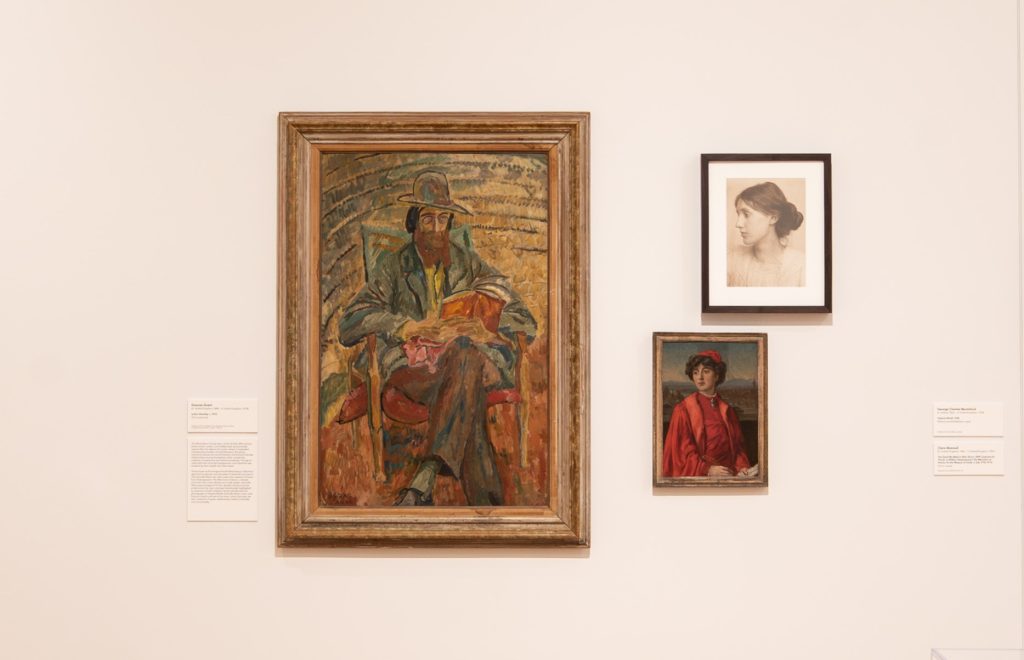
Sackville-West consented, writing back: “My God, Virginia, if ever I was thrilled and terrified, it is at the prospect of being projected into the shape of Orlando. What fun for you; what fun for me… Only I think that having drawn and quartered me, unwound and retwisted me, or whatever it is that you intend to do, you ought to dedicate it to your victim.” Sackville-West, like many of us, desires and fears the watchful gaze of her lover. She imagines her fictionalization as both a punishment and a transformation. Perhaps she realizes that any portrait Woolf can concretize will be poisoned by misrecognition or omission.
In an introductory essay for The First Homosexuals catalogue, Katz writes: “There is something powerful about images, especially for the socially marginal. They can act as sites of identification and emulation, not just an [affirmation]… Images not only represented what was real; they could also lend form to thoughts, fantasies, and dreams.”
Both Atwood’s and Woolf’s portraits were fantasies. In the former, Sackville-West is presented against a backdrop of Florence, not Venice, and her choice of character suggests a desire to disguise herself as a man, recognizing the inequity of her social status as a woman. If she were a man, she could have inherited her family home. In Orlando, Woolf offers Sackville-West a fictional recompense; the eponymous protagonist wins control of her family estate despite her sex. Both portraits gesture towards an impossible reality. After reading Orlando, Sackville-West wrote Woolf, telling her: “…You have invented a new form of narcissism—I confess—I am in love with Orlando.”
I thought of Sackville-West’s praise when I decided to write this essay for you, Avery. Like Woolf, I want to invent you for myself.
Because I envisioned the essay itself as a formal description of portraits I’ve taken for you, a critical response to various portraits from The First Homosexuals, and also an epistolary, fragmented record of our relationship. When I told you I was writing this essay, I confessed offhandedly that I often felt I idealized you in my writing. My desire to photograph and describe you in writing arose from a similar impulse, an attempt to make you permanent or possessable. I naively hoped you might prefer, like Sackville-West, this indeterminate, fantastic representation, even if you didn’t entirely recognize yourself.
Our friendship could be a series of footnotes, photographs I’ve taken, a list of the meals we’ve shared, the films you’ve shown me, or the books I’ve loaned you with my diaristic notes written in the margins.
For instance, after we both suffered mundane breakups, I pressed Shon Faye’s Love in Exile onto you, declaring it a manifesto for how we might change our definition of and approach to intimate relationships: platonic, romantic, or sexual. Our mutual friend, N., decided to read the book as well and texted me a photograph of a passage from the chapter on community: “To this day, friendships with other queer people (now, of course, including fellow trans people, lesbians, and bi women as well as cis gay men) are special to me, because they continue to act as an invitation towards self-possession.”
Later in the same paragraph, Faye suggests that friendship is more important for queer and trans people because they often fear and are victims of rejection by the community or family, which cisgender heterosexuals encounter less pervasively. I am reminded that our self-possession, as trans women, is a political imperative. When I ask to photograph you, or attempt to describe your personality or likeness, I believe I am urging you to no longer accept your suffering or self-negation as innate. I want you to reject the numbness and detachment that seem like our only possibilities in this transphobic society.
When I returned to the exhibition weeks later, I decided to spend the majority of my time with a pastel of James Baldwin created by Beauford Delaney.
Baldwin was introduced to Delaney by one of his classmates, Emile Capouya, who suggested he visit the artists’ studio in Greenwich Village. Baldwin was a 16-year-old student at DeWitt Clinton High School, and Delaney was 39. The two quickly developed a friendship that would endure for 38 years, until Delaney’s death in 1979. Baldwin’s adopted father, a Baptist minister, treated his eldest with scorn, calling him ugly, and resented his son’s interests in reading, writing, theater, and cinema. In Delaney, Baldwin discovered a mentor and father figure, someone who would nurture his intellectual and artistic aspirations.
In a 1964 exhibition introduction, Baldwin wrote that he was “the first living walking proof, for him, that a black man could be an artist.” Early in their friendship, the pair would often walk together through the streets of New York City. The artist taught Baldwin to see, directing his attention to “the light contained in every thing, in every surface, in every face.”
As Jennifer Bernstein wrote in a review of Through the Strange Door, an exhibition examining Delaney and Baldwin’s friendship, the artist painted “more than a dozen works depicting, inspired by, or dedicated to Baldwin.” Baldwin dedicated his short story collection Going to Meet the Man to Delaney, and also included him in the dedication for his nonfiction book No Name in the Street. The 1944 portrait of Baldwin included in The First Homosexuals was completed nearly a decade before Baldwin convinced Delaney to move to Paris, where both sought refuge from American homophobia and racism. This move, Baldwin wrote, had a transformative effect on Delaney and his artistic practice; his paintings underwent a “most striking metamorphosis into freedom.”
During this period, Delaney abandoned realism. The artist sat near a window in his Clamart house at all hours of the day. The window overlooked a garden, but everything was filtered through the leaves and branches of a large tree that pressed against the window. His work from this period embodied the fundamental concerns of his artistic career: light and movement.
In this portrait, Baldwin is smiling and handsome, portrayed against a royal blue backdrop and ringed by a lighter halo of color, as if he is a beatific, saintlike figure. His face is multihued, similar, I imagined, to the shimmering “oil moving like mercury in the black water of the gutter,” that Baldwin observed while the pair walked through New York City. The portrait is tender and flattering, the kind of image a father might commission to carry around in his wallet or display proudly on his desk. These two men found refuge in each other.
I wonder, Avery, if we are both seeking refuge. In each other. In fantasy.
If my memory can be trusted, we matched at least once on a dating app years ago. We both identified as gay. Neither of us messaged, because we were feckless or unable to imagine how we might relate. We finally met in person years later—as women—introduced to each other by a mutual friend. Afterwards, I told my ex-boyfriend you seemed sweet but extremely soft spoken and shy. I was unsure whether you liked me. Weeks later, you invited me on a walk so we could get to know one another better. We grew closer as my relationship soured; I had discovered my ex-boyfriend was cheating again. And you offered well-reasoned, non-judgmental advice as I considered breaking up with him.
I texted you one of my favorite Nan Goldin images, a photograph of Greer Lankton and her lover Robert Vitale lounging in bed. After Lankton’s sex change operation, Vitale, who identified as a gay man, broke off their relationship. I read this image as tragic. Vitale is running his hand through his hair and is turned away from Lankton, who looks somber and lonely while grasping her thin wrist.
An interviewer once asked Goldin about her role in documenting the AIDs crisis and the use of art, referencing this image of Lankton and Vitale. Goldin was uncertain as she reflected on this portrait of her friends: “I think [art] was a cry out of the wilderness of something, a cry out of the plague…. We watched everybody get wiped out, and there was nothing we could do.” Seven years after the photograph was taken, Vitale died from AIDs. Lankton died in 1996 from a drug overdose, fourteen years after the photograph was taken. Goldin is somber and impotent in the face of such loss, telling the interviewer: “I used to think that I could never lose anyone if I photographed them enough. In fact, my pictures show me how much I’ve lost.”
A portrait can also be an absence, a reminder of something or someone, lost.
Later, I used Goldin’s photo as a visual accompaniment to an essay describing the end of my abusive relationship. I wrote about the afternoon you, my ex-boyfriend, and I spent together at Hollywood Beach before a thunderstorm forced us to flee. Your curls looked perfect that day, like Julia Roberts in the ‘90s. And you were unusually exuberant, laughing at my ex-boyfriend’s oddly-timed and overfamiliar jokes. I could tell you were entertaining his antics to be close to me.
I wrote that essay to signal to you that I understood I should feel ashamed for remaining in that relationship, even as you reassured me otherwise and insisted I seemed rational and levelheaded. I called you recently while at an artist residency to update you on the progress of my novel, a fictionalization of this same abusive relationship, and offhandedly told you that I could not believe how poorly he had treated me. You were relieved and finally admitted, nearly a year after our breakup, that it was excruciatingly difficult to witness the prolonged dissolution of our relationship.
Your voice wobbled like a weathervane while we spoke on the phone, portending bad weather, and I understood for the first time that you had shared some indeterminate portion of the pain I endured.
Recently, I started listing you as my emergency contact, writing ‘partner’ whenever the form asks me to define our relationship, because I feel that friendship is too flimsy or vague a word to describe our relationship. When I mentioned my upcoming vaginoplasty, you anticipated my request and offered to accompany me and play caretaker. More than anything, I wanted you to witness this next milestone of my transformation as a woman.
As I exited The First Homosexuals, I loitered in the final section of the exhibition, most compelled by an image of a costume party at the Institute of Sexology, which is considered one of the first sexology research centers and trans healthcare clinics in the world. Magnus Hirschfield, who founded the Institute, was photographed alongside a dozen others. He is a paternal figure, replete with a potbelly and walrus mustache, and is holding the hand of his partner, Karl Giese. The group is joyous, playful, and self-serious, as if they could not collectively decide on a tone for the picture. The photograph was commonplace, a party snapshot, but it captured the reality of this place and the people who frequented the Institute, as patients or workers, while simultaneously invoking a dreamlike vision of queer community.
Near the exit, the walls were plastered with images from an infamous book burning in Nazi Germany; in May 1933, members of the German Student Union, a Nazi student group, broke into and occupied the Institute of Sexology. Several days later, the students removed the entire contents of the institute’s library and burned them in Berlin’s Bebelplatz Square. Hirschfield was in France during the book burning for a speaking tour, where he would remain in exile until his death in 1935. In Germany, the Nazis expanded legislation criminalizing homosexuality, detaining 50,000 homosexuals and deporting somewhere between 10,000 to 15,000 to concentration camps, where they were subjected to castration, medical experimentation, and death. I returned to the photograph of the costume party, reminded of Roland Barthes’ description of the photograph as “the living image of a dead thing.”
I thought of this image of Hirschfield the other day, after you asked if you could see the Polaroid I took of you on the roof. Initially, I was annoyed and reluctant to part with the photograph, which I planned to add to the growing pile on my desk. I intend to organize them into a book soon. An official archive. But I was in a sour mood and impulsively resolved to be less possessive. As I handed you the image, you said something about the rarity of physical images: “Everything is digital these days, but holding this photograph in my hands feels like, I don’t know, imagining the future.”
This sentiment has lingered with me. Naively, I like to believe these amateur photographs might one day join a crescendo of portraits that capture and reimagine life as a transsexual woman in the US. I imagine that together, like Woolf and Sackville-West, Delaney and Baldwin, or Kertbeny and Ulrichs, we can teach each other how to see and reimagine ourselves, and the world, even when we are no longer here.
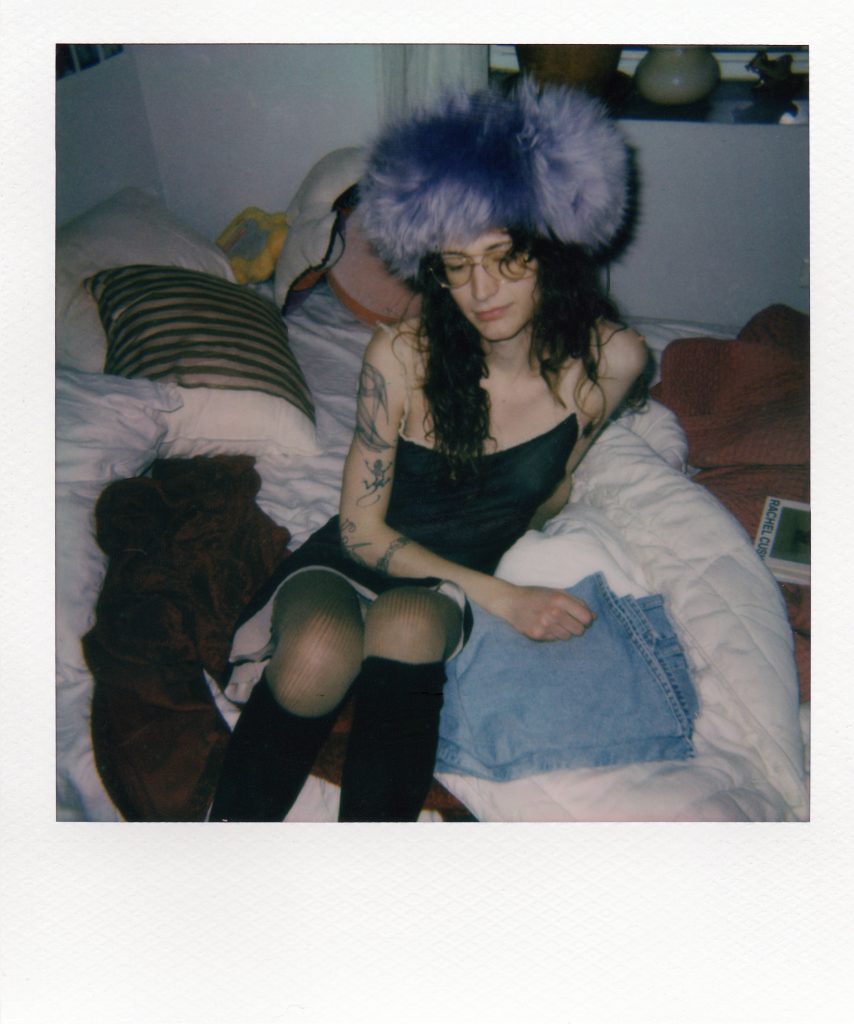
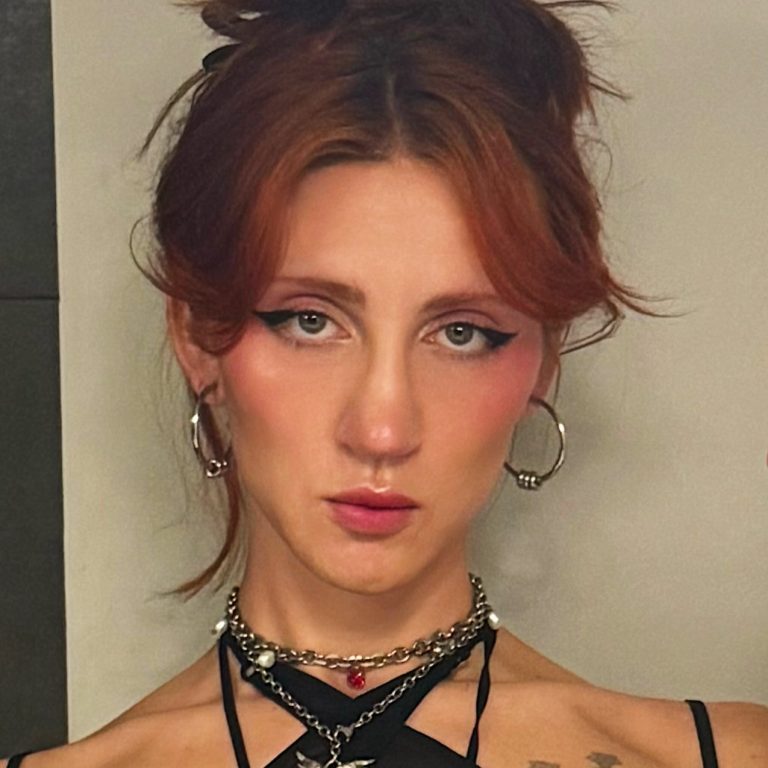
About the Author: Riley Yaxley is most often a dinner party host, a fishkeeper, a beach rat, a flâneuse, a glutton, a dancer, a delinquent daughter who forgets to call her mom; and she is also a writer, editor, and arts administrator.
The middle child of seven, Riley was born and raised in a Detroit suburb and currently lives in Chicago on the stolen land of the Ojibwe, Potawatomi, and Odawa peoples. She earned her BA and MA in Writing, Rhetoric, and Discourse from DePaul University, was a member of the 2023 Muña Art Writing Residency cohort, a 2025 ACRE resident, and participated in the 2025 Tin House Winter Workshop. Her work has appeared in Sixty Inches from Center, “A Great Gay Book,” “Skin, and Under,” and Catapult. She is currently an editor for Sixty Inches from Center.
